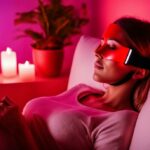Red light therapy is a popular technique used to improve various health conditions by using low-level red light wavelengths. However, there have been concerns about its safety for the eyes. In this discussion, we will explore whether red light therapy is safe for the eyes and what precautions should be taken.
Contents
Understanding Red Light Therapy
Red light therapy is a popular treatment that uses low-level wavelengths of red light to promote healing, reduce inflammation, and improve skin health. This type of therapy is non-invasive and has been used for various conditions, including acne, wound healing, and pain management. Red light therapy has gained popularity because of its minimal side effects and its ability to penetrate deep into the tissues.
How Does Red Light Therapy Work?
Red light therapy works by stimulating the production of ATP in the cells. ATP is an essential molecule that provides energy to the cells, and red light therapy can increase its production by up to 200%. This increase in ATP production helps to improve cellular function and promote healing. In addition, red light therapy can also stimulate the production of collagen, which is important for maintaining healthy skin.
Red light therapy is generally safe for eyes, using low-level wavelengths of light that are not harmful to the eyes. Studies have shown that red light therapy is safe for ocular use and can even improve vision and reduce the risk of age-related macular degeneration. However, it is still important to take precautions, such as following instructions provided by healthcare providers or therapists, wearing protective eyewear during treatment, and selecting FDA-approved devices that have been tested for ocular safety. Different types of red light therapy devices are available, each with unique features and benefits, such as light therapy lamps, panels, handheld devices, and infrared heating pads.
The Safety of Red Light Therapy for Eyes
One concern that people have when it comes to red light therapy is whether it is safe for the eyes. The eyes are sensitive to light, and exposure to high-intensity light can cause damage to the retina. However, red light therapy uses low-level wavelengths of light, which are not harmful to the eyes. In fact, some studies have shown that red light therapy can improve vision and reduce the risk of age-related macular degeneration.
Red light therapy is generally safe for the eyes as it uses low-level wavelengths of light that are not harmful to the eyes. Red light therapy works by stimulating the production of ATP in the cells, which helps to improve cellular function and promote healing. Research has shown that red light therapy is safe for ocular use and can even improve vision and reduce the risk of age-related macular degeneration. However, it is still important to take precautions to avoid any potential risks, such as wearing protective eyewear during the treatment and choosing safe FDA-approved devices that have been tested for ocular safety.
Research on Red Light Therapy and Eye Health
Several studies have investigated the safety of red light therapy for eyes. A study published in the Journal of Photochemistry and Photobiology found that red light therapy did not cause any damage to the retina and was safe for ocular use. Another study published in the American Journal of Ophthalmology found that red light therapy improved visual acuity and contrast sensitivity in patients with age-related macular degeneration.
Precautions to Take
Although red light therapy is generally safe for eyes, it is still important to take precautions to avoid any potential risks. If you are receiving red light therapy for a specific condition, it is essential to follow the instructions provided by your healthcare provider or therapist. You should also wear protective eyewear during the treatment to prevent any accidental exposure to high-intensity light.
Choosing Safe Red Light Therapy Devices
When choosing a red light therapy device, it is essential to select one that is safe for ocular use. Look for devices that are FDA-approved and have been tested for safety. Avoid using devices that emit high-intensity light or have not been tested for ocular safety.
The Science behind Red Light Therapy
The science behind red light therapy is based on the principles of photobiomodulation. Photobiomodulation is the process by which light energy is absorbed by cells and used to promote healing and reduce inflammation. Red light therapy uses low-level wavelengths of light to stimulate the production of ATP in cells. This increase in ATP production helps to improve cellular function and promote healing.
The Safety of Red Light Therapy for Eyes
Red light therapy is generally safe for eyes, but it is still important to take precautions to avoid any potential risks. The eyes are sensitive to light, and exposure to high-intensity light can cause damage to the retina. However, red light therapy uses low-level wavelengths of light, which are not harmful to the eyes.
Research has shown that red light therapy is safe for ocular use. A study published in the Journal of Photochemistry and Photobiology found that red light therapy did not cause any damage to the retina and was safe for ocular use. Another study published in the American Journal of Ophthalmology found that red light therapy improved visual acuity and contrast sensitivity in patients with age-related macular degeneration.
Precautions to Take
The Different Types of Red Light Therapy Devices
There are different types of red light therapy devices available on the market. Some of the most common devices include:
- Light therapy lamps
- Light therapy panels
- Handheld devices
- Infrared heating pads
Each of these devices has its own unique features and benefits. Light therapy lamps and panels are designed to provide full-body treatment, while handheld devices are ideal for targeted treatment. Infrared heating pads use red light therapy to deliver heat therapy to specific areas of the body, helping to soothe sore muscles and joints.
FAQs: Is Red Light Therapy Safe for Eyes?
What is red light therapy, and how does it work?
Red light therapy, also known as low-level light therapy (LLLT), is a non-invasive treatment that uses wavelengths of red light to heal damaged tissues, reduce inflammation, and improve circulation. This technology is used to treat a variety of conditions, from skin issues like wrinkles and acne to pain, fatigue, and depression.
Can red light therapy cause eye damage?
Research studies have shown that red light therapy is a safe and non-invasive treatment for many conditions, and it does not cause eye damage. Red light therapy uses low levels of light that do not emit harmful ultraviolet (UV) rays or heat. The wavelengths used in red light therapy are located in the visible range, specifically between 630 and 700 nanometers (nm). This range is not powerful enough to cause eye damage, even with prolonged exposure.
What precautions should I take to protect my eyes during red light therapy?
While red light therapy is considered safe for eyes, it is still recommended to take some precautions to avoid any accidental exposure. Eye protection, in the form of glasses or goggles, can be worn during treatment to shield your eyes from direct exposure to the light. You could also keep your eyes closed during the procedure to avoid any discomfort. It’s important to communicate with your physician or therapist before treatment to get their advice on the procedures to follow.
Are there any side effects associated with red light therapy for eyes?
Red light therapy is considered safe for eyes, and there are no significant side effects associated with the procedure. In some cases, individuals may experience mild headaches or eye strain after a session. However, these symptoms are typically short-lived and generally disappear within a few hours. You should communicate any such symptoms with your physician or therapist, and he or she will provide any necessary advice.








